Have you watched other horses play with toys and enjoy enrichment and thought, How do I teach my horse to play with toys? Have you given your horse stall enrichment or toys that they just ignore? Toys and enrichment are important for your horse’s welfare, but it can be disappointing and a waste of money when your horse doesn’t know how to use them. Let’s cover how to teach your horse to play with toys, and three ways to get your horse to use their enrichment items.
First, what IS enrichment for horses?
What Are Horse Toys and Enrichment for Horses?
Horse toys come in lots of shapes, sizes, and purposes. Just like toys for kids, toys for horses keep your horse’s mind and body occupied in positive ways.
Horse toys aren’t just for playing around, though! What might look like “toys” to us help horses express their natural behaviors. This can look like play and fun, but sometimes toys for horses encourage your horse to use their mind or just relax.
Some toys are made for horse use, others are made for other animals and repurposed for your horse. And some are DIY!
So why are toys important for your horse?
Why Do Horses Need Toys and Enrichment?
Toys help keep your horse occupied and engaged. They’re a type of enrichment for horses.
Enrichment is anything that encourages a horse’s natural behavior, like moving, grazing, using their senses, and solving problems. These behaviors are crucial for your horse’s happiness and physical health, especially if they have to spend time in a stall. Enrichment, including toys, is a must-have for the best horse welfare.
But providing enrichment and toys doesn’t have to be a chore – it’s exciting and fun for everyone!
If your horse plays with their toys and doesn’t just ignore their enrichment, of course.
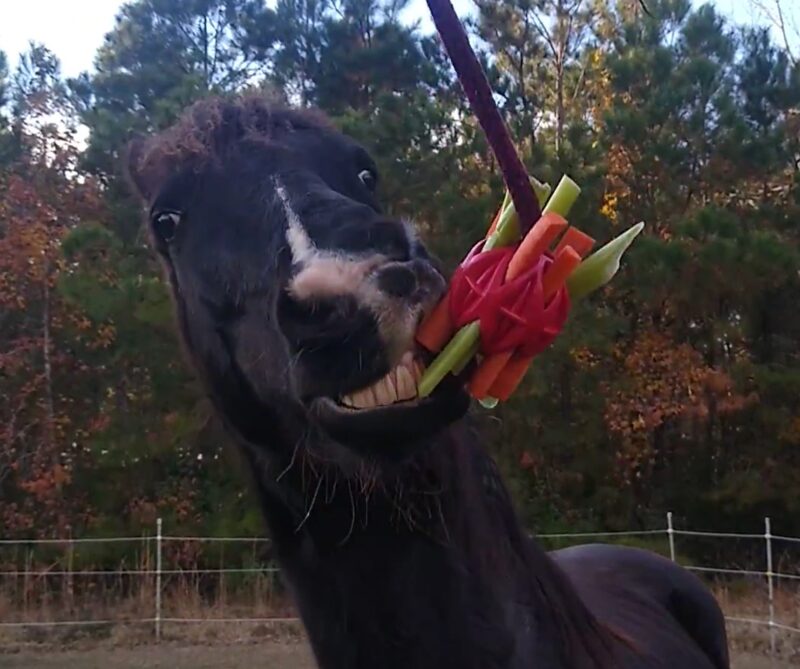
Why Is it Important To Teach Your Horse to Play with Toys?
If your horse is new to toys and horse enrichment, they may not understand how much fun their toys can be. Using toys and enrichment is a skill for horses, and it takes time and practice! It’s a lot like riding a bike: riding is fun once you know how, but definitely takes time to learn. For your horse to get the benefit of enrichment, they’ll need to learn what to do – so you might have to take the time to teach your horse to play with toys.
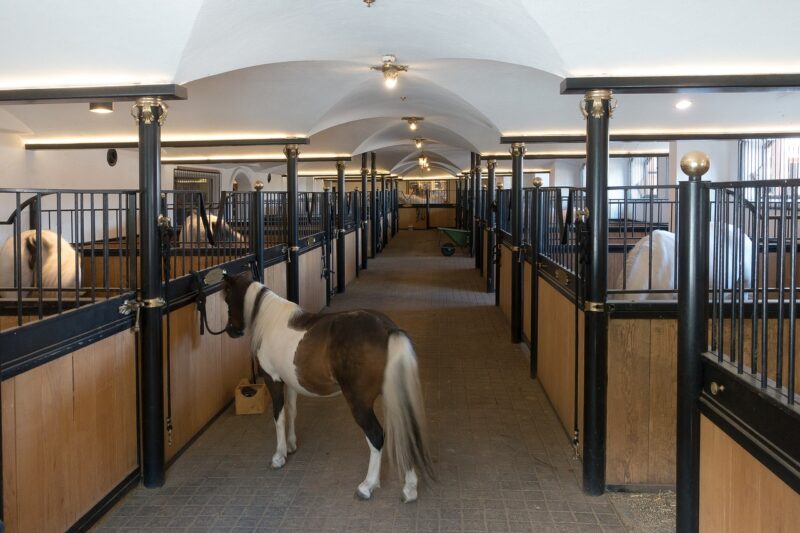
This is especially true if your horse is used to a carefully managed, human-oriented stable situation. Many barns are set up for people in mind more than horses. Horses used to tightly managed schedules and “safe” but empty paddocks and stalls with no enrichment may have no idea that they CAN play with toys.
If your horse comes from this background, you’re doing the right thing by giving them toys and enrichment. But they’ll probably be unsure of what to do, and need some extra help from you to figure out how much fun horse toys can be.
Signs that You May Need to Teach Your Horse How to Play with Toys
Horses that understand their enrichment activities really LOVE their toys and other items. They look forward to their next plaything, puzzle, or exciting offering and jump right into problem-solving and interacting with new items.

If that doesn’t sound like your horse, don’t worry! Your horse can still learn to use toys and get all the benefits of enrichment. It just means that introducing them may take a little extra work.
Here are some signs that your equine friend doesn’t understand how to use or enjoy toys:
- They ignore a toy completely or sniff it and walk away without touching or using it
- They’re fearful of new toys, showing nervous or anxious body language
- They attempt to use a toy or puzzle and become frustrated or aggressive
- They enjoy the toy but use it in an unintended way
If your horse shows any of those behaviors, you might think My horse doesn’t like toys. But it’s likely that what’s actually happening is a lack of understanding. It’s also possible you haven’t yet found the toys your horse likes and needs.
Let’s cover the ways you can encourage your horse to use enrichment and teach them how to play with toys.
Encourage but Don’t Force It
Enrichment and toys should be voluntary and fun for your horse.
When you introduce a new toy, let your horse investigate it at liberty. Don’t try to pull them closer to a new toy, make them touch it, or “guide” them with your hands or a whip into using it the right way. If your horse feels like they must use their toy because you want them to, it can make them avoid it later on.
Instead, provide lots of incentives and rewards for exploring their toy. When you first give them a new item, you should focus on calm exploration and a little bit of independent use.
Start with Simple Horse Toys
The purpose of each horse enrichment or toy seems obvious to us. But it’s important not to take that knowledge for granted!
After all, horses are intelligent but don’t think the same way as people. When you give them a new toy or enrichment, they might not know what to do or understand that the new object can be fun or rewarding.
If your horse seems to write off toys and puzzles as just one more piece of human clutter in their stall, you may need to start simple. REALLY simple.
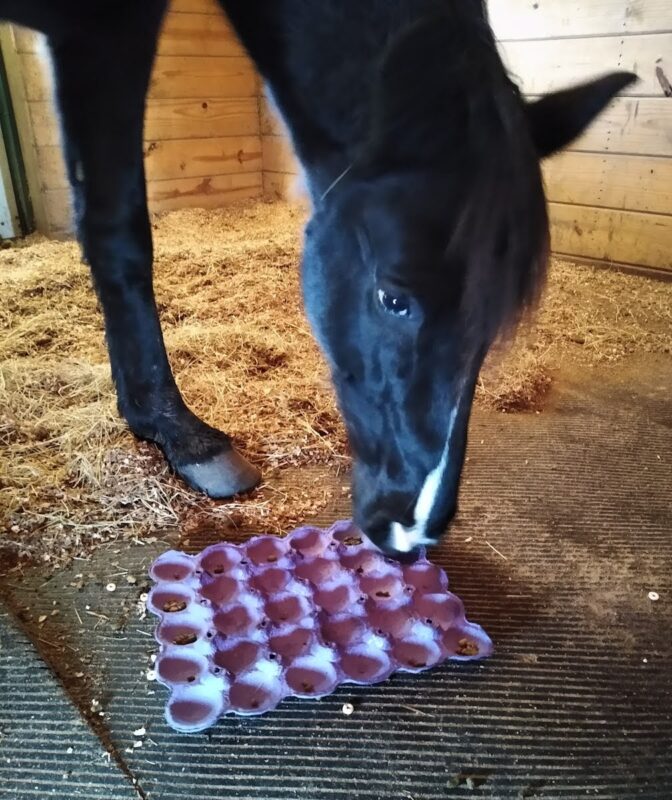
When your horse is new to enrichment items, use the easiest and most basic enrichment you can think of. Make the goal as obvious as possible. Most puzzles for horses involve seeking food. You can help your horse understand by putting food around or on top of the item.
Your horse is picking up new skills and practicing behaviors that may be a little rusty, like using their senses to find food on their own. You may need to create “baby versions” of each item to help them learn. Simplify enrichment by introducing lightweight toys that are easy to move, or puzzle boxes with easy shallow textures.
Speaking of food…
Add Easy Food, Even if Treats Aren’t the Point
Not all enrichment items and toys for horses are used with food. But when you’re teaching a horse to play with toys, using food can help them learn.
Placing food near a new item helps them associate the new toy with good feelings. Placing food on top of a new enrichment item encourages your horse to touch the toy. Your horse has to learn that the new item moves or feels interesting and that they have control over it, so a strategically placed treat can really help. Just touching or nudging a new toy is the first step to teaching your horse how to use it.
If you’re teaching your horse to use a puzzle feeder or foraging toy, easy food helps them learn how to use the enrichment. In addition to hidden food or treats tucked into textured areas, include some easy-to-reach treats to show your horse how rewarding their food is.
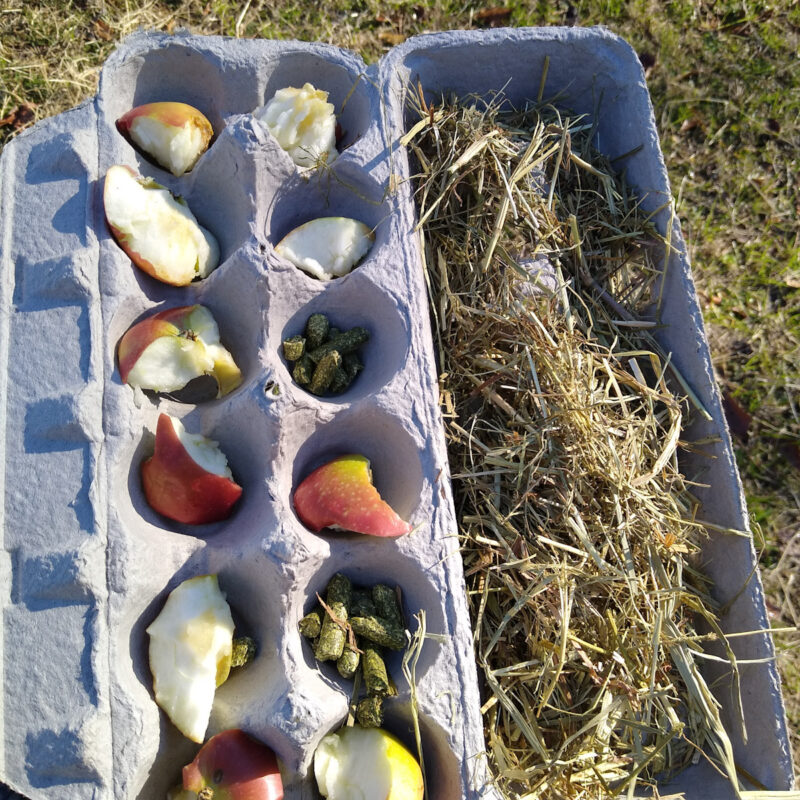
For Jolly Balls and other play items, a little molasses or peanut butter spread on the toy’s handle is a good way to teach your horse to put their mouth on the correct part of the toy.
When they figure out how to use the item the right way, you can fade out the use of extra treats.
Watching Other Horses Play with Toys
Horses are herd animals and are wonderfully social. They are attuned to the emotions and actions of the horses around them. Horses watch their herdmates’ actions and body language almost constantly. You can take advantage of this when you teach your horse to play with toys.
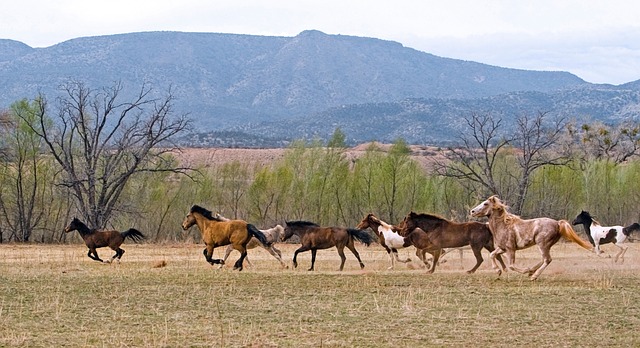
Learning a skill by watching others do it (monkey see, monkey do) is called social learning. The science is mixed on whether horses can truly learn how to do something just from watching another horse. But it’s clear that having a confident and puzzle-savvy friend will help your horse approach new toys with confidence.
Watching another horse play with a toy or solve a treat puzzle shows your horse that the new item isn’t dangerous. They may mimic their herdmate and begin using their new toy faster.
Use this technique if your horse isn’t much of a go-getter with toys but has an experienced, trusted pasturemate. Offer an enrichment item to an experienced horse in view of the inexperienced horse. Let them watch the puzzle pro use the enrichment the correct way. If your horse seems interested after seeing the other horse have a good time with their treats or puzzles, offer the same enrichment item to them.
Safety in Numbers
If you have a group of friendly horses who are comfortable sharing, group enrichment is a great way to teach your horse to play with toys. The more experienced, braver horses will use the enrichment first.
Eventually, when the inexperienced horses see their herdmates eating treats and safely exploring or playing with the toy, they’ll get curious and jump in.

Use this technique if your horses are comfortable sharing resources. To prevent arguments or competition, it’s a good idea to put out several of the same toy or enrichment item so that horses can enjoy them alone if they prefer.
Horses will also learn from others how to use non-food-related pasture enrichment. Watching another horse use scratching pads or mud wallows is a great way for them to learn.
Teach Your Horse to Play with Toys using Training
You can teach the horse how an enrichment item works using positive reinforcement training. Positive reinforcement is reward-based training – clicker training is a good example.
In a positive reinforcement training session, you give your horse a reward – usually food – when they do something correctly. By building behaviors a small step at a time, you can teach your horse new skills in a force-free and enjoyable way. This works really well for teaching horses to solve food puzzles. Once you teach your horse to use the toy, they’ll be able to enjoy it on their own in the future.
Teaching your horse to play with toys and use enrichment is simple with positive reinforcement. Shape the behavior bit by bit, rewarding your horse for small steps like approaching and then touching the new toy.
When they perform the behavior that’s correct for the toy or puzzle – like rolling a treat ball with their nose – mark the behavior with a generous reward thrown near the toy to mimic the real payout from the feeder.
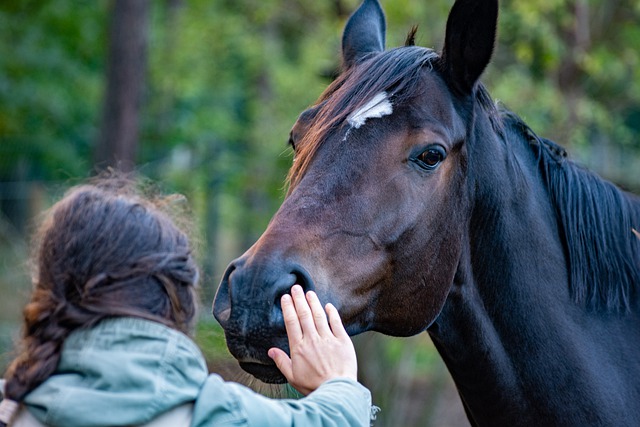
To teach your horse to play with toys using positive reinforcement, you’ll need to make a shaping plan. This is a step by step breakdown of the skill that keeps you on track and helps your horse learn. This horse trainer’s planner is an ideal tool for creating shaping plans for teaching your horse all kinds of skills – including using enrichment!
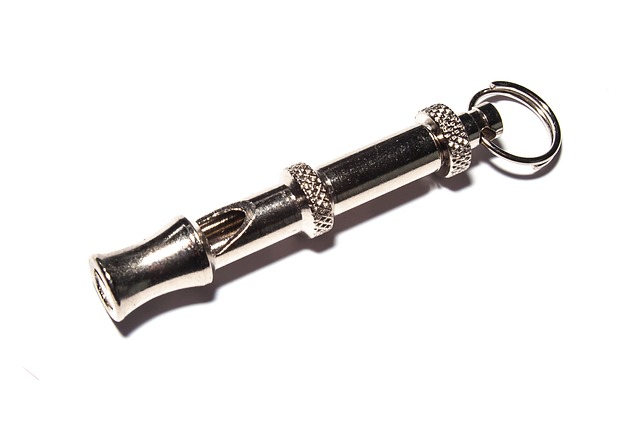
Teach Your Horse to Play with Toys: Definitely Doable
The takeaway is that it’s very possible to teach your horse to play with toys. This fundamental part of horse care is very achievable, even if your horse has ignored toys in the past. Don’t be surprised if your horse needs some learning time when figuring out enrichment, especially in the beginning.
With these techniques, your horse will be tackling the toughest puzzles and having fun with toys and enrichment before you know it.

Pingback: How To Make a Rolling Treat Ball [DIY Horse Enrichment] - Enriching Equines